
USS Hartford, a sloop-of-war steamer, was the first ship of the United States Navy named for Hartford, the capital of Connecticut. Hartford served in several prominent campaigns in the American Civil War as the flagship of David G. Farragut, most notably the Battle of Mobile Bay in 1864. She survived until 1956, when she sank awaiting restoration at Norfolk, Virginia.

The second USS Portsmouth was a wooden sloop-of-war in the United States Navy in service during the mid-to-late 19th century. She was designed by Josiah Barker on the lines of a French-built privateer, and built at the Portsmouth Navy Yard, directly across the Piscataqua River from Portsmouth, New Hampshire. She was described as an improvement over USS Saratoga built in the same shipyard a year earlier. Portsmouth was launched on 23 October 1843 and commissioned on 10 November 1844, with Commander John Berrien Montgomery in command.

The first USS Pensacola was a screw steamer that served in the United States Navy during the U.S. Civil War.

USS Plymouth, a wooden-hulled screw sloop-of-war, was the second ship of the United States Navy to be named for Plymouth, Massachusetts.
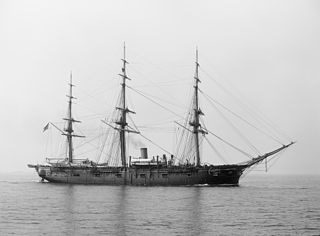
The first USS Lancaster was a screw sloop-of-war in the United States Navy during the American Civil War through the Spanish–American War.
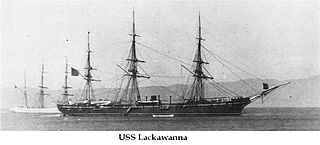
The first USS Lackawanna was a screw-propelled sloop-of-war in the Union Navy during the American Civil War. She was named after the Lackawanna River in Pennsylvania.
The first USS Mohican was a steam sloop-of-war in the United States Navy during the American Civil War. She was named for the Mohican tribe and was the first ship of her class.

The first USS Iroquois was a Mohican-class sloop of war in the United States Navy during the American Civil War.

William Halford was a sailor, and later an officer, in the United States Navy. He also received the Medal of Honor.
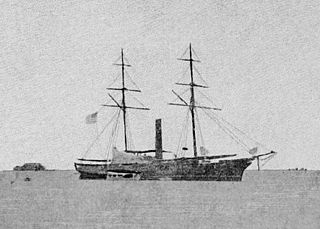
The first USS Saginaw was a sidewheel sloop-of-war in the United States Navy during the American Civil War. The ship was in operation throughout the 1860s, but in 1870 wrecked on what is now known as Kure Atoll, a Pacific island. The event produced several books and one of the surviving boats from the ship is in a museum.

The first USS Narragansett was a 2nd class screw sloop in the United States Navy during the American Civil War. Narragansett was built at the Boston Navy Yard, launched on 15 February 1859, and commissioned on 6 November 1859.

The first USS Jamestown was a sloop-of-war in the United States Navy during the Mexican–American War and the American Civil War.

The second USS Mohican was a steam sloop of war in the United States Navy. She was named for the Mohican tribe.

Henry Glass was a rear admiral in the United States Navy, best remembered for his role in the bloodless capture of Guam in the Spanish–American War. He was also a Union veteran of the American Civil War.
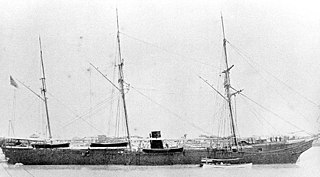
USS Wachusett – the first U.S. Navy ship to be so named – was a large (1,032-ton), Mohican-class steam sloop-of-war that served the United States Navy during the American Civil War. She was outfitted as a gunboat and used by the Navy as part of the Union blockade of the Confederate States of America.
USS Resaca was a third-class screw steamer of the United States Navy. Built at Portsmouth Navy Yard, Maine at a cost of $201,229.19, the ship was launched on 18 November 1865, and commissioned in 1866, Comdr. J. M. Bradford in command.

The first USS Alaska was a wooden-hulled screw sloop of war, built at the Boston Navy Yard and named for the then-newly acquired territory. The ship was launched on 31 October 1868 and sponsored by Miss Grace Hull, the daughter of Mayor Liverus Hull of Charlestown, Boston. Alaska was commissioned on 8 December 1869, with Commander Homer C. Blake in command.
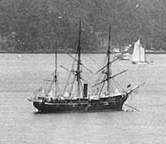
As part of the Secretary of the Navy George M. Robeson's plans to overhaul and modernize ships of the Navy, the first USS Swatara was taken to the New York Navy Yard in 1872, ostensibly for "repairs". In fact, the "repairs" constituted construction of a new ship, for Swatara was given a new hull and unused machinery which had been in storage since 1865. Embodying only certain fittings and equipment from the first ship, the second Swatara was launched on 17 September 1873 at the New York Navy Yard and commissioned on 11 May 1874, Capt. Ralph Chandler in command.

Franklin Jeremiah Drake was a Rear Admiral in the United States Navy. He fought in the American Civil War and the United States expedition to Korea.

Charles Jackson Train was a rear admiral in the United States Navy. He served in the Spanish–American War and later as the second Commander-in-Chief of the United States Asiatic Fleet.


















